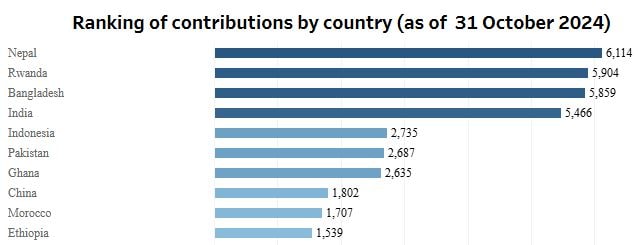Jaishankar reiterates Indian commitments to UN Peacekeeping: What this means
Since the 1950s, India has contributed over 290,000 peacekeepers across more than 50 UN Peacekeeping missions. Here is what to know about them and why India has remained one of the biggest contributors of troops over the years.
 Indian soldiers patrol under a UN Peacekeeping mission in Congo, Africa. (Wikimedia Commons)
Indian soldiers patrol under a UN Peacekeeping mission in Congo, Africa. (Wikimedia Commons)External Affairs Minister S Jaishankar highlighted India’s commitments to supporting Global South nations in building their peacekeeping capacities at the inaugural ‘Conference for Women Peacekeepers from the Global South’ on Monday (February 24).
“Through initiatives led by the Centre for UN Peacekeeping, India will continue to offer training and capacity-building programs, including courses specifically designed for women peacekeepers, as we did with ASEAN countries in 2023,” Jaishankar said. “India strongly believes that peacekeeping is an effective instrument in the maintenance of international peace and security,” he added.
Since the 1950s, India has contributed over 290,000 peacekeepers across more than 50 UN Peacekeeping missions, Jaishankar said. Today, more than 5,000 Indian peacekeepers are currently deployed in nine of the 11 active peacekeeping missions. Here is what to know about them and why India has remained one of the biggest contributors of troops over the years.
First, what are UN Peacekeeping missions?
The idea of UN Peacekeeping stems from the UN having no military forces. Therefore, Member States voluntarily provide the military and police personnel that are periodically required for each peacekeeping operation from their national forces.
Peacekeepers usually wear their countries’ uniforms and are identified as UN peacekeepers only by a UN blue helmet or beret and a badge. They are tasked with protecting civilians, actively preventing conflict, reducing violence, strengthening security, and empowering national authorities to assume these responsibilities.
Officially, they are allowed to use force at a tactical level, with the authorisation of the Security Council, if acting in self-defence and defence of the mandate. In general, a UN peacekeeping operation should only use force as a measure of last resort.
They are also to help host countries become more resilient to conflict, laying the groundwork to sustain long-term peace and addressing root causes of conflict, the official website says.
How many UN Peacekeeping missions have been carried out?
More than 71 Field Operations have been undertaken since 1948, following collaborations between the UN Secretariat, the Security Council, and the countries that contribute uniformed personnel. More than 100,000 military, police, and civilian personnel from 125 countries currently serve in 14 peacekeeping operations.
 Ranking of countries’ contributions to providing peacekeeping troops. (Via peacekeeping.un.org)
Ranking of countries’ contributions to providing peacekeeping troops. (Via peacekeeping.un.org)
The first UN peacekeeping mission was established in May 1948, when the UN Security Council authorised the deployment of a small number of UN military observers to the Middle East to form the United Nations Truce Supervision Organization (UNTSO) to monitor the Armistice Agreement between Israel and its Arab neighbours. Early on, troops and police came from a relatively small number of countries and were almost exclusively men.
Who funds UN Peacekeeping Missions?
The UN Security Council makes decisions about establishing, maintaining, or expanding peacekeeping operations, while all UN Member States are collectively tasked with financing them. Every member is legally obligated to pay their respective share under Article 17 of the Charter of the United Nations. The United States (26.95%) and China (18.69%) pay the most, partly because they are part of the UNSC. India’s share is around 0.2088%.
Peacekeeping soldiers are paid by their Governments according to their own national rank and salary scale. Countries volunteering uniformed personnel to peacekeeping operations are reimbursed by the UN at a standard rate, approved by the General Assembly, of US$1,428 per soldier per month as of 1 July 2019.
What’s behind India’s contributions?
For one, sustained participation in a key UN programme is thought to help bolster India’s standing in the international community. It may also help its claims towards securing a seat in the UN Security Council as a permanent member. However, the expansion of the P5 is based on multiple factors, perhaps the most important being how willing the existing members are to share power.
More broadly, the efficacy of peacekeeping missions has also been questioned, given the costs. UN data states that as many as 179 Indian military personnel, including some central armed police forces personnel, have laid down their lives while serving as UN peacekeepers.
There is also disagreement among countries about the provision of troops, with most coming from developing countries. Troops and police personnel data from October 2024 says the US provided 26 workers while the UK provided 275. The biggest contributor, Nepal, was at 6,114 while India stood fourth at 5,466.
Another view traces the distribution of troops as being dependent on the interests of respective countries rather than a genuine interest in conflict resolution. This could mean foreign exchange for poor African and Asian countries, or strategic interest — such as China looking at commercial gain in Africa or India seeking to bolster its claim to a permanent Security Council seat.
- 01
- 02
- 03
- 04
- 05






































